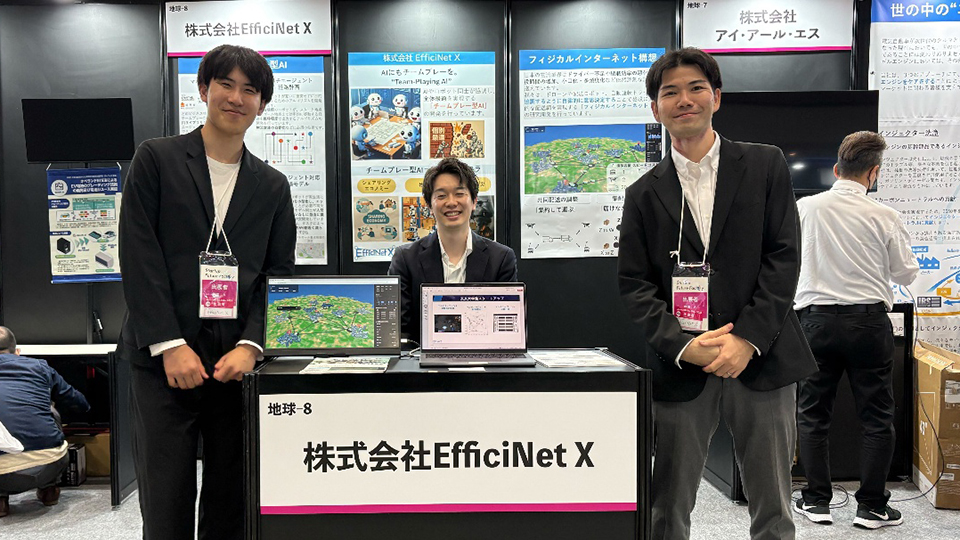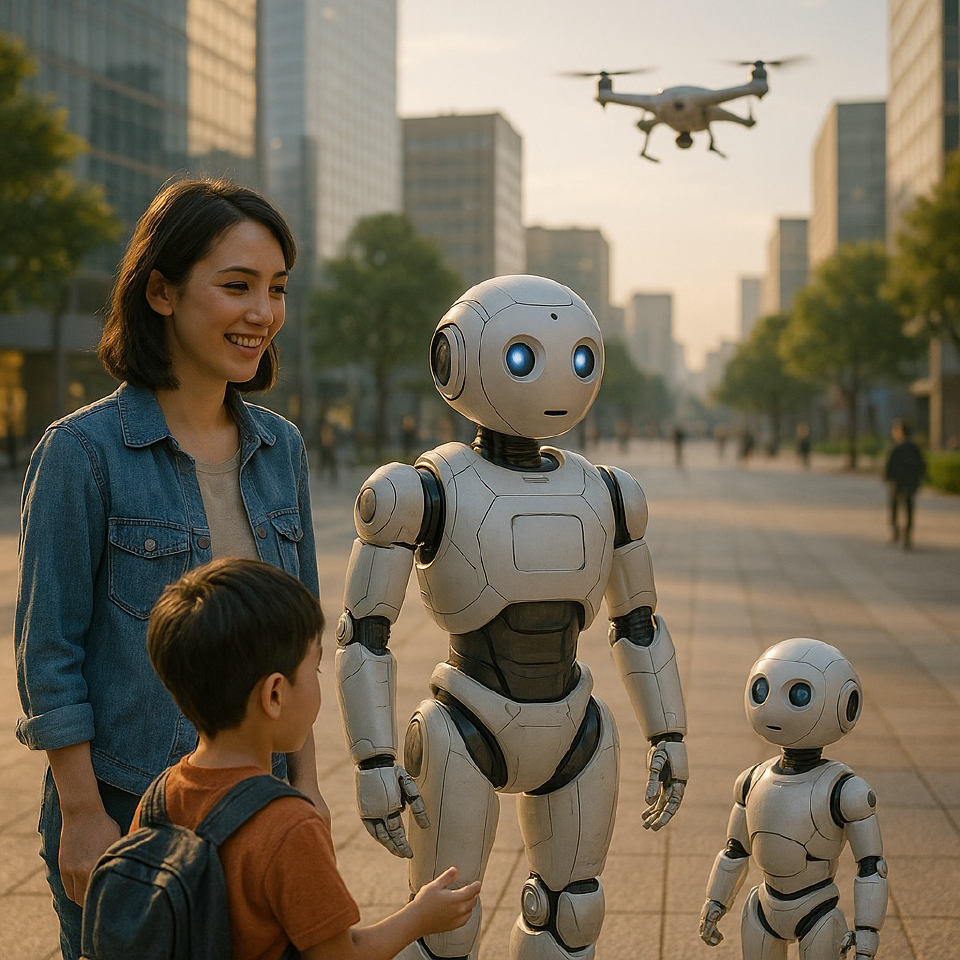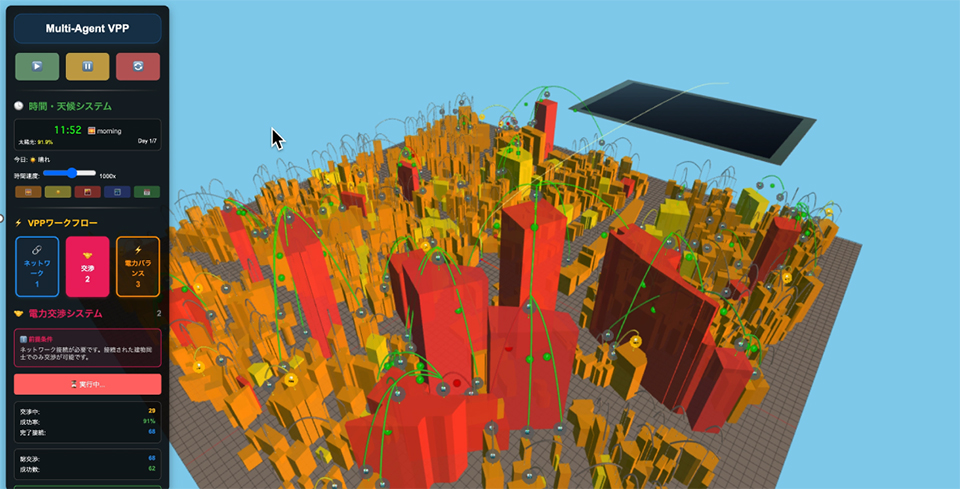- TOP
- About
- Affiliated League
- Information
- Column
- Media Information
- Job Information
- League Report
- League Members
- Partners
-
公式X
Search League Members
From document creation to image generation and music composition—as AI technology permeates every corner of society, its evolution is now entering a new phase. Conventional "single-agent AI," which works alone, is beginning to face a wall in terms of computational processing power and scalability when it comes to controlling tens of thousands of robots or optimizing complex social infrastructure. Addressing this challenge is EfficiNet X, Inc., a startup dedicated to developing and socially implementing "team-play AI" (multi-agent AI), where multiple AIs collaborate and cooperate with each other.
Shintaro Nakamura, CEO of the company, is a young entrepreneur who earned his doctorate from the University of Tokyo's graduate school researching "Development of a General-Purpose Multi-Agent Deep Reinforcement Learning Library." We delve into his cutting-edge vision of how this "team intelligence" aims to solve challenges in core societal fields like logistics, energy, and disaster prevention, and pioneer a future where AI and humans co-exist.
 Exhibit at the Japan Mobility Show 2025
Exhibit at the Japan Mobility Show 2025Could you tell us about your background?
Nakamura: After graduating from the University of Tokyo's Faculty of Engineering, Department of Mathematical Engineering and Information Physics, I completed my doctoral program at the Graduate School of Frontier Sciences, earning a Ph.D. I enjoyed my math classes at university and had a vague interest in AI, so I researched AI learning in my doctoral program, specifically "reinforcement learning."
What specific field of AI is "reinforcement learning"?
Nakamura: There are broadly three methods of AI learning. One is "unsupervised learning," a method of classifying (clustering) images of dogs and cats without teacher data (labels).
Another is "supervised learning." This is a method where a human acts as a teacher, providing correct answers (labels) to a large amount of data in advance, like "This is a cat image" or "This is a dog image." The AI learns the difference between cats and dogs based on this correct data.
The last one is "reinforcement learning," which is my specialty. With this method, as long as you provide a simulation environment for learning, the AI learns on its own, accumulating what humans would call experience points. For example, if you design a simulation where a virtual robot arm repeatedly tries to grasp a virtual block and receives a positive evaluation value called a "reward" upon success, the AI will autonomously learn the optimal actions to maximize this reward.
You reportedly started your company in 2023, while in the second year of your doctoral program. What led you to do that?
Nakamura: When I thought about the best way to realize my ideas quickly and proactively, I decided that rather than getting a job as an engineer at a company, it was best to put myself in the high-pressure situation of a startup and focus on learning about ever-evolving AI at the forefront. I met the founding members through communities like the one created by Professor Yutaka Matsuo of the University of Tokyo (a leading figure in AI research in Japan). The initial four members were three engineers—a friend and a junior colleague who were interested in AI for logistics, and myself—plus a former teammate from the University of Tokyo's varsity soccer club. My soccer teammate wasn't an engineer, but he created the company logo we still use today.
What specifically does the research and development of "team-play AI" at EfficiNet X involve?
Nakamura: We are developing algorithms for robots and software to behave cooperatively with each other to accomplish various tasks. This is a field called "multi-agent systems," as opposed to a single "single-agent."
For example, in the logistics field, delivery robots, drones, and autonomous trucks can cooperate to flexibly create optimal schedules, building a robust logistics network that ensures supplies are delivered without interruption even during disasters. It's an image of thousands, or even tens of thousands, of AI-equipped robots performing "team play."
Is it already being implemented in the business world?
Nakamura: Currently, our main activity is listening to the challenges and needs of various companies and proposing solutions using team-play AI. Examples like effectively linking dispersed processes A, B, and C in a manufacturing plant to enhance overall performance are easy for them to visualize, and many companies have shown interest.
It seems like it would be more efficient to have a single, highly capable AI act as the overall controller. What's the difference compared to regular AI?
Nakamura: That's a question I get a lot. For example, when you have thousands or tens of thousands of robots in a logistics warehouse, a centralized AI trying to process everything from a "god-like" position will hit its limits in terms of computational ability and resources. Scalability is the challenge for single-agent AI. On the other hand, if the robots make decisions autonomously, they require almost no computational resources. We are developing the algorithms for that.
Furthermore, in disaster sites with unstable communications, the ability to make autonomous decisions and cooperate with each other without waiting for communication with a central command is essential. These are the major reasons "team-play AI" is needed.
Is developing a multi-agent system like team-play AI more difficult than developing a single-agent AI?
Nakamura: In terms of the reward function that drives the AI, a single agent pursues its reward function by optimizing its own actions. In contrast, a multi-agent's reward function depends not only on its own movements but also on the movements of others. For example, when performing a coordinated task with robot arms, if you don't consider how the other arm will move in addition to your own, the optimization will fail.
This kind of processing, which is like game theory (the theory of analyzing strategies for decision-making by multiple players under mutual influence) where "you decide your own move by considering the opponent's move," is something that current AI, which specializes in optimizing its own movements, has not been able to achieve. This is similar to how humans form teams and organizations to function in society, and it becomes more advanced and difficult.
 Demo of the "Physical Internet" exhibited at the Japan Mobility Show 2025. Autonomous trucks, drones, and delivery robots autonomously decide which packages to handle, constructing a logistics network.
Demo of the "Physical Internet" exhibited at the Japan Mobility Show 2025. Autonomous trucks, drones, and delivery robots autonomously decide which packages to handle, constructing a logistics network.In the logistics field, "smart logistics" solutions like automated warehouses are emerging. What new value does the AI created by EfficiNet X bring to this?
Nakamura: In current smart logistics, I believe that well-developed solutions have been achieved in individual areas like "picking" and "transport," and further improvements are being pursued in this "partial optimization."
However, I think there is still room to improve performance in the "connecting" parts between processes, such as linking picking robots and transport robots. An approach like team-play AI becomes effective here.
For example, when an instruction "Pick item A, put it on a transport robot, and ship it" comes to the warehouse, conventional AI aims to optimize the process of the picking robot carrying item A and the transport robot optimizing its movement to the shipping exit, individually. With this method, if the transport robot is delayed due to external factors like congestion, the picking robot wastes time waiting at the loading bay.
"Team-play AI" maximizes the performance of the entire warehouse by having all robots within it predict and coordinate their movements with each other in real-time. We believe there is room to create new technologies and services by complementing each other and achieving overwhelming efficiency in this "overall optimization" domain, which other companies have not yet deeply explored.
What other application examples are there in the energy sector?
Nakamura: Renewable energy sources like solar and wind, which are currently gaining attention, have unstable power generation, making real-time supply and demand balancing across an entire town essential. An application can be considered where AIs distributed in each home and building communicate with each other and cooperate on adjustments like "reduce usage by this much during this time slot," thereby controlling power consumption and building a resilient infrastructure that prevents blackouts. Team-play AI will autonomously perform this adjustment, which is currently handled by humans.
You commented, "I think Doraemon is the ultimate form of AI." It's true that Doraemon also collaborates with Nobita and friends to achieve many things.
Nakamura: In the history of AI research, it has long been questioned whether AI can possess a "body (physicality)" and a "mind (emotions, thoughts)." Doraemon has both the hardware of a high-performance robot and the software to empathize with humans, co-existing with them without any sense of incongruity. Moreover, unlike current AI that just gives convenient answers, Doraemon also gives Nobita advice that is hard to hear, but for his own good. The future of team-play AI also has this "co-existence with humans" at its core, so Doraemon, who meets the conditions for that, can be called the ultimate form of AI we are aiming for.
So, you are ultimately thinking about the co-existence of AI and humans?
Nakamura: For example, if you think about work inside a warehouse, it's not just robots there. To make it easier to understand for social implementation, we are first focusing on collaboration between robots using AI, but as team-play AI is introduced, I feel that humans and AI working together will also happen in the near future.
 A society where humans and robots co-exist
A society where humans and robots co-existHow do you see the team-play AI market developing in the future?
Nakamura: At this point, we are strategically targeting areas where the shortage of computational resources for single-agent AI is a clear problem, such as logistics and energy, and are moving forward with concrete proof-of-concept (PoC) experiments. In this field, Japan is lagging behind the rest of the world in both academia (university and public research) and business deployment, and I don't see any prominent companies competing with us.
We are promoting team-play AI as "different from previous AI." The element of "considering others," which was not present in conventional AI, is a technology that can be applied to basically any field. Stock trading is precisely a place where multi-agent systems are functioning. From that perspective, team-play AI might have the potential to break through.
So it holds potential for application in various fields, such as finance.
Nakamura: On the other hand, it's also important for humans who accept AI to update their thinking. For the market to get another push, I think the shortest path to social implementation is for "team-play AI" to become a buzzword, just like "big data" or "generative AI." It's not just that "what AI can do has increased" due to scientific and technological development, but that a cultural boom of "let's increase what AI can do" precedes it, attracting market capital and public attention, which in turn advances research. I think this can be said from past examples in the AI field.
What was your reason and purpose for joining the ICT Startup League?
Nakamura: The main purpose is to raise our visibility and gain the know-how to scale this business. We are still a startup, so being selected for a program like this, which brings social trust and recognition, is extremely valuable.
What specific results have your activities in the league led to?
Nakamura: Since joining, I've found it very stimulating to learn that there are many entrepreneurs of my generation facing similar challenges. Even if our businesses are different, the worries of a startup CEO, like fundraising and hiring, are common. I am learning how to further accelerate the speed of my business through valuable advice from senior entrepreneurs and horizontal connections with my peers.
What do you feel is the biggest current challenge, technologically or market-wise, in advancing the practical use of team-play AI?
Nakamura: Even if "team-play AI" successfully becomes a buzzword, it's meaningless if our own capacity can't handle it. There are various themes like fundraising and business planning, but the immediate challenge is to improve our organization's sales skills to be able to explain our complex technology in an easy-to-understand way to companies considering its adoption, and to clearly communicate its innovation and merits.
You've stated your goal is "to apply team-play AI to all industries."
Nakamura: The real world has many uncertain elements that pure game theory alone cannot handle, such as how weather deeply affects energy control in a smart city. It's difficult to build algorithms that account for such probabilistic events, but I am working on research and development believing that when we achieve it, it will be a complete upgrade to current AI and applicable to all industries.
It's also about preparing for a "world where humans and AI co-exist" by bringing AI closer to human thought. Humans are equipped with the ability to self-organize, just like in soccer, where each individual can make their own judgments to play as a team. I believe AI will surpass humans in a sense when it can achieve that. Whereas humans are limited to team play within the bounds of their imagination, AI team play might calculate and draw out abilities that are not currently apparent, or make judgments that transcend human preconceptions about categorization and role assignment.
Believing in the new value that will be brought about by the co-existence of humans and AI, I want to further evolve the development of this technology and explore its adoption in more companies and industries.
 The "Multi-Agent VPP (Virtual Power Plant)" conceived as an application of team-play AI in the energy sector. AIs in each household negotiate with each other to adjust the power supply-demand balance during emergencies. As a result, the entire city's power usage is optimized. The lines in the demo indicate AI agents negotiating with each other.
The "Multi-Agent VPP (Virtual Power Plant)" conceived as an application of team-play AI in the energy sector. AIs in each household negotiate with each other to adjust the power supply-demand balance during emergencies. As a result, the entire city's power usage is optimized. The lines in the demo indicate AI agents negotiating with each other.Editor's Note
Mr. Nakamura's concept of "team-play AI" provided a fundamental perspective, re-framing AI not just as a high-performance tool, but as an "autonomous agent" closer to a member of human society. The fact that his sense of "cooperation" and "overall optimization," cultivated through soccer, is the source of his ideas for world-leading AI research is extremely unique.
The concrete applications in logistics and energy presented in the interview suggest that the so-called "god-like" AI is already reaching its limits, and I strongly felt the potential for EfficiNet X's technology to establish a unique presence in the global AI competition.
"Applying AI to all industries, towards a Doraemon-like world where humans and AI co-exist"—I want to watch with excitement Mr. Nakamura's future challenges toward this grand vision.
■ICT Startup League
This is a support program that started in fiscal 2023, triggered by the Ministry of Internal Affairs and Communications' "Support Program for R&D in Startups."
The ICT Startup League supports startups through four pillars.
①R&D Expenses / Accompanying Support
Up to 20 million JPY in R&D expenses is provided as a subsidy. Additionally, in accompanying support, the screening committee members involved in selecting league members continue to stay by their side after selection to promote their growth. For companies that the screening committee members evaluated as "absolutely want to select," a support system is built where the committee members themselves continuously provide advice on business plans and offer growth opportunities, truly a "fan-like" support system.
②Discovery & Nurturing
We provide opportunities for learning and encounters that promote the business growth of league members.
We also work to discover people who aim to start businesses in the future, aiming to expand the base.
③Competition & Co-creation
It serves as a place for positive competition, like a sports league, where startups learn together and compete constructively, earning the funds they truly need (up to 20 million JPY). It also provides a place for co-creation where league members can collaborate and expand their businesses through various opportunities, such as sessions by the screening committee members.
④Promotion
We will publicize the initiatives of league members in collaboration with the media! By letting many people know about their businesses, we aim to expand opportunities for new matching and chances.
■Related Websites
EfficiNet X, Inc.
/
EfficiNet X, Inc. (LEAGUE MEMBER)
/
ICT Startup League